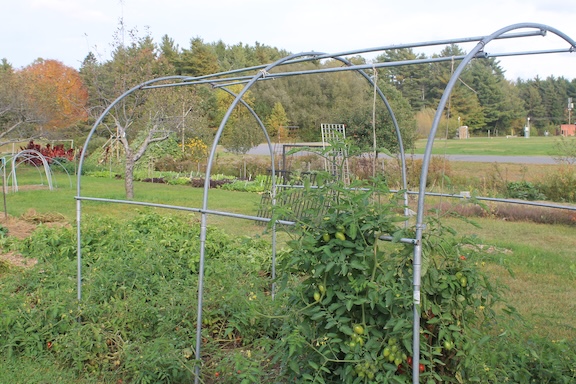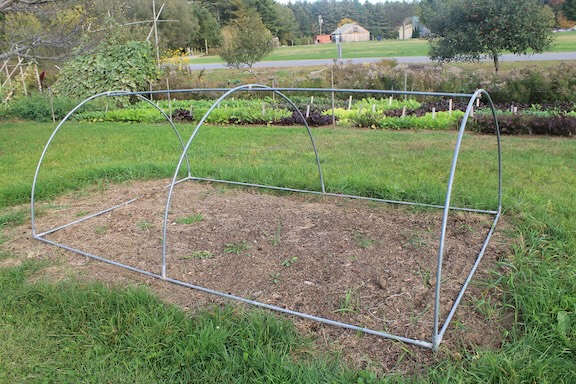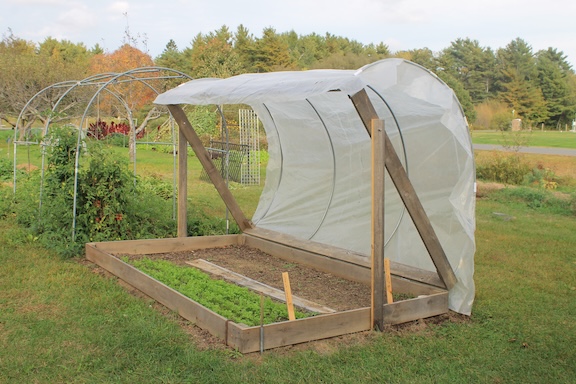By Jack Kertesz, MOFGA’s Landscape Coordinator
I am excited about using hoop structures to extend the growing season as I think they are overlooked and underrated for their practical, economically sound, and user/builder-friendly attributes.
DIY Structures Made from EMT
Quick Hoopsentered the market garden scene around 2009, advocated for by Eliot Coleman and marketed by Johnny’s Selected Seeds. They were intended to be a more weather-worthy support structure for row cover material and/or greenhouse plastic, providing season extension in the colder months and even over the winter. The hoops, configured from 10-foot sections of galvanized conduit (the type used to shield electrical wires, called electrical metallic tubing or EMT), can be bent to form arches covering 3-foot, 4-foot, or 6-foot-wide areas (with a corresponding decrease in height) using an appropriate-sized bender. The hoops are meant to be stuck in the ground at regular intervals, allowing for easy removal and relocating as demanded by crop cycles.
While this system was adopted by market gardeners, at about one-fifth the cost of a typical greenhouse, it appeared that gardeners could also employ EMT-built hoops with ease, if modified for smaller-scale applications. Constructing 6-foot-by-10-foot wooden bases for the widest 6-foot model seems like the simplest solution for both a semi-portable and a fixed-to-the-ground structure. Three or four EMT hoops can then be fastened with bolts to the frame. Add greenhouse-quality plastic and a few snap-on clips to attach it to the tubing and you’re done.
I had built a few of these myself before I discovered a company called Build My Own Greenhouse.BMOG supplies various fittings in many tubing sizes to create freestanding structures. The fittings easily slide over the tubing and can be secured with metal-fastening tech screws. Their straight 6-inch-long couplers are what made the taller frame pictured here possible. Initially, I struggled to build taller units with off-the-shelf EMT connectors. As I had a number of joint failures using them, I was pleased to find an alternative coupler.
A recent internet search revealed another company offering DIY parts. Colorado Metal Worx carries an assortment of pieces including door hinges and latches and a few other novel connectors. Using either or both of these companies should allow for creating the growing structure of your choice. Other build options might include a chicken tractor, arbor, shade canopy, lemonade stand, or even a firewood dryer/shelter.
Why EMT Tubing?
People have messed around with various materials to support crop-covering materials including rebar (its rough edges easily rip lighter fabrics) and black poly water pipe (a bit too flexible, it won’t withstand snow loads). PVC pipe is a bit sturdier than the black poly, but it is a toxic material when produced, when cut, and when disposed of. It is also recommended that PVC get painted as the unpainted pipe can assist in degradation of greenhouse plastic films. It, too, doesn’t support snow loads.
EMT will last for a long time, it is relatively easy to bend and easy enough to source, and structures built using it should provide adequate crop protection through the seasons. There are numerous DIY videos available on how to bend EMT. One could also invest in a commercially made product and then sell or share it. Some Maine Cooperative Extension offices have benders available to use on site.
Examples of DIY Structures on the MOFGA Grounds

A 6-foot-wide by 6-foot-tall by 10-foot-long structure made from ¾-inch tubing, shown here, could be used to support and protect eight indeterminate tomato plants or a larger number of peppers, support horizontal netting for cut flowers, or be used to secure trellising material for vine crops. Two 10-foot lengths of ¾-inch EMT were cut into 40-inch lengths that, when used with couplers, created the six legs needed to increase the height. A couple of additional pipes were also placed along the top to help secure twine for trellising tomatoes (which didn’t get completed in 2024).
Another structure on the MOFGA grounds is a stand-alone low hoop structure that is very easy to relocate as needed. It uses the following pieces: four (three-way) corners and two hoop-to-bottom rail “tees” for the base, plus three hoop-to-purlin (the top pipe) cross connectors.

Finding a simple solution for neatly and securely covering the end walls for these structures has always plagued me. We have used pieces of plastic custom cut for the end walls and attached with clips, or at times just left the ends open. Be aware that being able to vent these small enclosures is absolutely necessary. Adding hinged doors is an idea I am attracted to but have yet to try.

Another season-extending structure is a flip-open hoop structure that I call a “clamshell.” This structure, essentially a hinged wooden frame sitting atop a lower wooden base, can be easily cobbled together. The 6-foot by 10-foot size makes for efficient use of plastic, wood, and tubing. Two boards attached along the inside edge of the base act as vertical braces when the lid is lifted, preventing it from flipping open further or suddenly snapping shut. I used two large nails as removable pins to facilitate opening and closing. A length of rope, cable, or chain could be added as an additional measure of security. One could use 1×6, 1×8, 2×6 or 4×4 lumber of your choice to build the base, depending on the longevity and portability you desired. I built the top frame to the same dimension using two lengths of 6-foot pieces and two 10-foot pieces of 1×6. Corners for both of these frames should be reinforced with blocks of wood or L-shaped metal brackets.
As with any of these structures, adding plastic creates a “sail-like” structure.
I definitely recommend adequately securing the base of these to the ground. Wooden or metal stakes can be driven into the soil and secured to the base with screws or anchor bolts.
Trial and Error in the Field
These structures have little mass to support very tender crops during colder temperatures. Selecting more resilient, cold-hardy plants is key to overwintering or prolonging the season for fresh produce. Johnny’s Selected Seeds’ Growers Library has various articles offering more details on the regular quick hoop system, vegetables to try, and guidelines on sowing.
You are likely to run into inconsistent weather patterns at both ends of the calendar. Your timing of planting and your selection of crops, and even varieties, will influence the outcome.
Baby spinach and baby mustard greens are at the top of the list for growing under cover. They are less susceptible to frost damage than adult-sized plants and occasionally will survive the winter, sometimes even when unprotected.
I mostly think of these structures as storage units, holding a space to allow cool-season plants to last a bit longer, buffering the temperature while the season ebbs and flows. With minimal construction and a little attention, they can help to provide fresh ingredients for your household at both ends of the growing season. Hoop, hoop, hooray!
This article originally appeared in the spring 2025 issue of The Maine Organic Farmer & Gardener.
